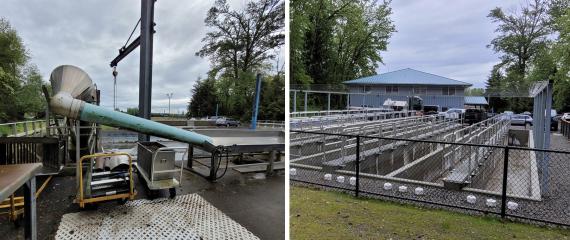Tribal fisheries using excess government equipment to help restore Pacific Northwest salmon populations
Resident orcas are the heart of the Puget Sound. Three Resident Southern orca pods return to the Salish Sea every year to feed on fresh salmon, which routinely arrive via the plentiful Washington rivers. But in the 1990s, the population dropped so low, salmon became protected by the Endangered Species Act. In turn, the orca population also suffered.
Government agencies, including Tribal nations and non-profit organizations stepped in to help the once booming salmon population bounce back. Hatcheries and fisheries located along streams and rivers where salmon live and spawn are using science - and excess federal property - to return more salmon to local waters.
Through the Bureau of Indian Affairs, tribes like the Puyallup Tribe can apply for excess government equipment and supplies for use at fisheries at no charge. Area Property Officer Trey Dyer recently visited Puyallup Fisheries Director Russ Ladley to better understand his operation and how GSA excess can continue to support their mission.

Ladley and Fisheries Enhancement Chief Blake Smith led Dyer on a tour of three of their facilities to show him exactly how excess government equipment is already in use. At the Diru Creek Salmon Hatchery, staff collect female salmon before they spawn. The Fisheries staff “bleed the females,” meaning they remove the eggs and wash off the blood so they fertilize better (female salmon die after they spawn). The eggs are then fertilized and placed in incubators. When they start to hatch, the staff move the young salmon to custom-made salmon runs, crafted by a welder using sheets of scrap metal discarded from Joint Base Lewis McChord. Many of the tools and other equipment they use to maintain the incubators, runs and other equipment was transferred through GSA’s Office of Personal Property Disposal.

Once the fish get a little larger, they are moved to acclimation ponds, like those at the Clarks Creek Salmon Hatchery. Here, they help prepare the fish for release into the Puyallup River. Birds that feed on the young prey threaten the young salmon. Using netting obtained through the excess program, staff work to protect the bulk of the salmon until they are ready for release. Various tools and equipment here are also former government property - including obsolete law enforcement boats, tools and even a discarded freezer once used in the (human) infertility department of a Veterans Affairs hospital.
At the Wilkeson Creek Rearing Ponds, young salmon prepare for release. This is a critical point in the restoration process, and the staff aim to keep these ponds well protected. A long metal gate greets drivers who wish to enter. This gate was also once in use on government property, but was no longer needed.
“Russ and his team are awesome at what they do,” said Dyer. “Participating in site visits gives Area Property Officers like myself a chance to see how beneficial excess federal property can be for our customers. As a Washington resident, I’m grateful for the opportunity to serve a role in such a meaningful mission within our community.”
The Puyallup Tribe operates 11 fisheries facilities in the Puget Sound area. The tribal fisheries “monitor the status of salmon populations both within and outside its jurisdiction and strive to maintain healthy, harvestable salmon populations for the benefit of all.”

 U.S. General Services Administration
U.S. General Services Administration